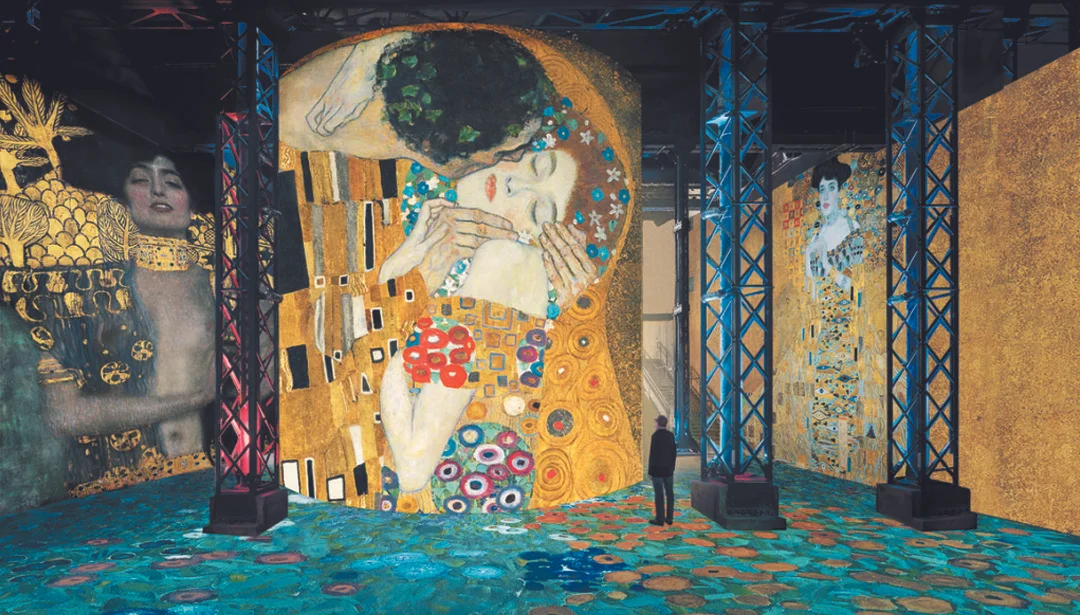Projecting the Canvas: Bourse de Bruxelles and L’Atelier des Lumières
by Carina Imbornone
Installation view of Gustav Klimt at L’Atelier des Lumières. © Culturespaces / E. Spiller. Image from TTT Magazine.
Two venues in Europe have recently mounted shows relying on projection to excite audiences. Van Gogh: The Immersive Experience at the Bourse de Bruxelles, Belgium and Gustav Klimt at L’Atelier des Lumières, Paris, have explored the potential of projected moving images through the showcase of well-known artworks.
While this tactic is a bit of a novelty, I would argue that the real power of such exhibitions comes from the use of projection in wide-scale gallery spaces.
Light, the primary medium of the projection show, has always been one of the foremost tools of the artist from Vincent Van Gogh to James Turrell. It has also been a formative part of the club and underground party scene, where projections and flashing lights are used to supplement both the trance of the music and drug use common in these venues.
The value of a projection show, from a financial perspective, is immense. Compare the cost of a projector with the cost of a Van Gogh, of which there is only one original; the most expensive Van Gogh to be sold at auction, The Portrait of Doctor Gachet, sold for upwards of 80 million USD, while the most high end of projectors go for 100,000 a piece.The art-projection show may therefore help cut costs in the museum space by allowing museums to display artwork they do not actually own.
How will this change the meaning of a a museum? What does a hallowed hall of reproductions mean to collectors, gallerists, artists, and viewers? The uniqueness of a work—that a certain museum is the only place in the world where a work can be seen—has long been one of the cornerstones of the museum experience. Art museums, as meditative, communal spaces devoted to aesthetic exploration, require incentive to draw crowds to unique works. That is where the experience of a light show, one where you can watch Klimt’s Woman in Gold refract and reflect light on many surfaces, only to disappear in an instant, replaced with swirling tones of gold and green, becomes the art.
This presentation is often packaged in a way that amounts to a gimmick, as the real paintings are not really there. If this trend hopes to survive and emerge as a viable medium for the display of art, it needs to act more within the space of what might be found in a club or concert. These projections, when done well, can display imagery with the carnivalesque force of the party scene. This energy has often interfaced with the art world, as the highbrow aspects of the art world constantly draw from what is lowbrow and underground. This pattern has exhibited itself many times in the past decade: Andy Warhol’s Factory and Velvet Underground, Susanne Bartsch’s drag scene parties, and the constant contemporary interplay between the fashion industry and “cyberpunk”, queer online content creators such as Karim Boumjimar.
However, these projection shows are not highbrow—they are decidedly made to show the most art to the most people in a populist act of rebellion against the rules of the museum. As an attendee of both these museums, I saw couples old and young, many with children, in attendance. These were not the typical crowds; they skewed young. The gift shop in L’Atelier des Lumières contained many children’s products and the Vincent Van Gogh exhibition included a coloring page room. Neither light show explored explicit or even mature themes, which is uncharacteristic of the use of projected images in nightclub and underground scenes. This tension between digital, club scene art and the new potential to display well-known works will have to be resolved to promote the medium of projected moving image in the art museum space.
Installation view of Gustav Klimt at L’Atelier des Lumières. © Culturespaces / Nuit de Chine. Image from artnet.
Gustav Klimt, along with several other light shows which were on display at L’Atelier des Lumières, has now ended. The new season of L’Atelier des Lumières will open on February 22 with Van Gogh: The Starry Night and other works. L’Atelier des Lumières is located at 38 rue Saint Maur, in the 11th arrondissement of Paris.
Van Gogh: The Immersive Experience at the Bourse de Bruxelles is on display until 27 January 2019.


